- Quick Read
- Deep Read ( 7 Min. )

Why is Christian Science in our name?
Our name is about honesty. The Monitor is owned by The Christian Science Church, and we’ve always been transparent about that.
The Church publishes the Monitor because it sees good journalism as vital to progress in the world. Since 1908, we’ve aimed “to injure no man, but to bless all mankind,” as our founder, Mary Baker Eddy, put it.
Here, you’ll find award-winning journalism not driven by commercial influences – a news organization that takes seriously its mission to uplift the world by seeking solutions and finding reasons for credible hope.
Explore values journalism About usIn Today’s Issue
- Hamas leader’s death revives hopes for a Gaza peace plan
- Today’s news briefs
- Elon Musk spends big to boost Trump. Republicans worry it might flop.
- Canada-India relations are at a new low. China could be the winner.
- Transformed FEMA faces torrent of challenges to growing relief efforts
- How to have better conversations with people across the aisle
- Finding ‘Wonderland’ at the New York Botanical Garden
Monitor Daily Podcast
- Follow us:
- Apple Podcasts
- Spotify
- RSS Feed
- Download
TODAY’S INTRO
The good that’s all around, if we look for it
 Mark Sappenfield
Mark Sappenfield
We usually talk about our own stories in this space, and appropriately so. But today, I stumbled upon this podcast as I was scanning the Morning Dispatch newsletter: “Country Over Self.” The synopsis says, “Country Over Self and Country Over Party have always been cornerstones of the American Presidency.”
Sometimes, it can seem that seeking mutual humanity and our higher natures can be a lonely place in today’s media landscape. But it’s not. The podcast was a welcome reminder to look for the good all around. It’s out there to be found.
Share this article
Link copied.

Help fund Monitor journalism for $11/ month
Already a subscriber? Login

Monitor journalism changes lives because we open that too-small box that most people think they live in. We believe news can and should expand a sense of identity and possibility beyond narrow conventional expectations.
Our work isn't possible without your support.
Hamas leader’s death revives hopes for a Gaza peace plan
After a harrowing year of war in Gaza and the Middle East, the death of Hamas leader Yahya Sinwar rekindled hopes for a grand U.S.-led plan to move the region into a more peaceful era. But many obstacles, Israeli and Palestinian, remain.

-
Taylor Luck Special correspondent
The death of Hamas leader Yahya Sinwar, mastermind of the Oct. 7 attack on Israel that led to a year-plus of war in Gaza, has shaken the region like an earthquake.
The questions now are on whether his death might facilitate the Gaza cease-fire and hostages release deal the Biden administration has promoted for months. And even more, revive the regional plan under consideration before the war, including Saudi-Israeli normalization and a pathway to a Palestinian state.
Almost immediately, President Joe Biden signaled his hope that removal of the Sinwar obstacle would jump-start peace efforts. Indeed, several Gulf Arab diplomats appeared Friday to want to jump on the Biden “opportunity” bandwagon, seeing a chance to advance the plan that had been grounded for months and even to prevent an Israel-Iran war.
Yet words of caution abound, with some doubting whether Israeli Prime Minister Benjamin Netanyahu is ready to subordinate his domestic political considerations.
“This should be an opportunity to advance the Biden initiative, which envisions a resolution of longstanding regional issues,” says Nimrod Novik, a former Israeli government official. “But the cork in the bottle for all of this is Gaza, and if you don’t uncork Gaza, you can’t get to the rest.”
Hamas leader’s death revives hopes for a Gaza peace plan

Just over a year ago, the Biden administration was pressing Middle East partners forward on a transformative plan for the region that would include normalization of relations between Israel and Saudi Arabia and a definitive pathway to a Palestinian state.
Then Hamas leader Yahya Sinwar launched the surprise Oct. 7 attack on Israel – one of his motivations being to scuttle an American peace plan that seemed increasingly imminent.
A devastating war in Gaza – and expansion of the conflict to Hezbollah in Lebanon and to Iran – ensued.
Now Mr. Sinwar has again shaken the region like an earthquake, this time with his death in a firefight Wednesday with Israeli soldiers on patrol in Gaza.
The question now is whether the Oct. 7 mastermind’s death might facilitate the Gaza cease-fire and hostages release deal the Biden administration has promoted for months – and even revive the grand regional plan.
For many experts, the answer depends heavily on navigating both ambitious Israeli war goals and internal Palestinian divisions.
Almost immediately, Thursday, President Joe Biden signaled his hope that removal of the Sinwar obstacle would jumpstart peace efforts.
“There is now the opportunity for a ‘day after’ in Gaza without Hamas in power, and for a political settlement that provides a better future for Israelis and Palestinians alike,” Mr. Biden said in a statement.
Indeed, several Gulf Arab diplomats appeared Friday to want to jump on the Biden “opportunity” bandwagon, seeing a chance to advance the plan that had been grounded for months and even to prevent an Israel-Iran war.
But the president’s optimistic assessment is most likely premature, many regional analysts and diplomatic experts say. If anything, some add, Mr. Sinwar’s death is likely to lead to a reorganizational period for Hamas, while it could embolden Israel in ways that put off any resolution even further.
“Any advancement in plans by Arab states depends heavily on Israel’s policy moving forward,” says Hesham Alghannam, Saudi political scientist and non-resident scholar at the Carnegie Middle East Center.
“If Israel sees this as an opportunity to further its objectives and continues its aggression on Gaza without concessions, as it did in the past, it will hinder Arab Gulf state efforts.”

“There have been two preeminent decision makers in this conflict,” Mr. Sinwar and Israeli Prime Minister Benjamin Netanyahu, “and I don’t believe the disappearance of one is going to mean the necessary steps for ending this war are going to happen any more quickly,” says Aaron David Miller, a longtime Middle East diplomat.
It’s not just a question of agreeing to a cease-fire and freeing the hostages, says Mr. Miller, who served in both Democratic and Republican administrations. “Those things mandate critically important questions that won’t be answered easily.”
Among them: What security authorities will exist in postwar Gaza that will ensure no resurgence of Hamas? What role will there be for the Palestinian Authority? Will there be Arab countries’ boots on the ground?
A shift, but not an end?
For Mr. Miller, Mr. Biden’s suggestion that Mr. Sinwar’s removal opens a window to resolve the conflict underscores once again the issue of timing.
“The Hamas clock and the Netanyahu clock are not running as quickly as the Biden administration’s, and it’s just not realistic to think Sinwar’s death has done anything to synchronize these clocks,” he says.
“This is a moral issue and a legacy issue for a president who had hoped to resolve this before leaving office,” notes Mr. Miller, now a senior fellow in U.S. foreign policy at the Carnegie Endowment for International Peace. “That’s very different from the considerations motivating the next steps of either Netanyahu or of an organization taking time to consider its future.”
The demise of a key player whose overarching goal was the destruction of Israel will alter the course of the conflict, others say, but less than conclusively.
“Yes, this does present an opportunity for a shift … but at best it’s going to be a change to a different phase in the Gaza piece of this,” says Seth Jones, president of the Defense and Security Department at the Center for Strategic and International Studies in Washington. “This doesn’t bring an end to anything.”
The “opportunity” he sees is for the Israelis, specifically Mr. Netanyahu, “to move into a phase that is more diplomatic and starts to address these big governance and security questions hanging over Gaza.”
Some with insight into both U.S. and Israeli politics agree that the moment presents an opportunity – but they doubt Mr. Netanyahu is ready to subordinate his domestic political considerations to seize it.
“This should be an opportunity to advance the Biden initiative, which envisions a resolution of longstanding regional issues,” says Nimrod Novik, a former Israeli government official and Israel fellow with the Israel Policy Forum in Washington.
“But the cork in the bottle for all of this is Gaza,” he says, “and if you don’t uncork Gaza you can’t get to the rest.” But he says that would imply doing things in Gaza – including much more extensive humanitarian assistance and some role for the Palestinian authority – that couldn’t pass muster with part of Mr. Netanyahu’s government.
“Unfortunately, for Netanyahu his coalition is more precious than even bringing back the hostages,” he says.
And nothing suggests a desire in the government coalition to move forward with the Americans.
Bezalel Smotrich, a far-right cabinet minister, posted on social media platform X shortly after Sinwar’s death was confirmed that he “hears the talk abroad about ‘an opportunity to end the war,’ from those who tried to pressure us to stop the war a long time ago and stop us from entering Rafah.”
“If they are aiming right now at a surrender deal in which Israel dumps the achievements of the war that were bought with a lot of blood, I tell them – to forget about it,” he wrote in the post.
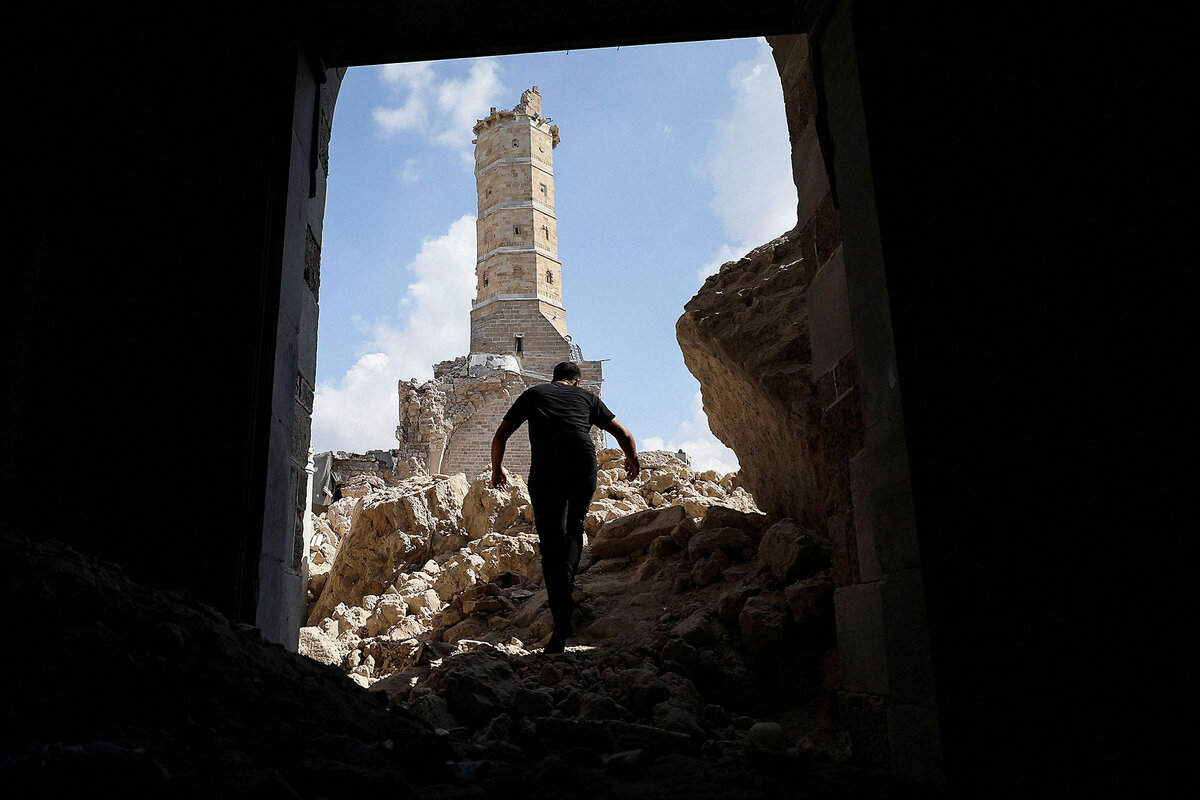
Achieving a meeting of the minds
Still, some Israeli analysts hold out hope that the government can move beyond its most extreme members to seize the moment.
Shimrit Meir, who advised former Israeli Prime Minister Naftali Bennett, is among those also urging Mr. Netanyahu’s government to take advantage of the void in Hamas leadership.
“Sinwar was a symbol the de-facto leader of the Palestinian national movement. He was the kind of leader you see once in a generation, the fact that he’s gone allows for a reshuffling of the cards,” she told the Israeli podcast “Unholy.”
Meanwhile, Arab Gulf states on Friday were pitching the day-after plan not only as the off-ramp to the Israel-Hamas war, but as a key to easing regional tensions.
“Sinwar’s killing gives us momentum. There are no Hamas hard-liners standing in our way,” says an Arab Gulf diplomat who was not authorized to speak to the press. “But the ball is now in Netanyahu’s court.
“The main components for the day-after plan for Gaza have all been agreed upon by us Gulf states, the EU, and the Americans,” the diplomat said. “A technocrat Palestinian Authority entity, no Hamas in government, Gulf-funded reconstruction, and security guarantees for Israel.”
Although Arab states have been holding high-level discussions with Israel over the initiative for months, “we have been given conflicting messages from the Israeli government whether Israel supports the plan, or is ignoring it completely,” the diplomat added.
That assessment does not take into account continuing indecision and disagreement among key Palestinians on how to move forward.
While the main five Arab states involved – Jordan, Egypt, Saudi Arabia, UAE, and Qatar – are unanimous on the plan, infighting among Palestinian factions has hindered the final talks over any new Palestinian governing entity.
“The internal Palestinian political landscape, marked by factionalism and infighting, serves as a significant barrier,” says Dr. Alghannam, the Saudi analyst.
“These divisions not only complicate immediate post-war governance and security arrangements but also hinder the broader objective of creating a sustainable, unified Palestinian state or administrative entity,” he says.
Most experts see Israel pursuing its military operations in Gaza and against Hezbollah in Lebanon no matter how much the U.S. promotes the moment as providing an off-ramp from war.
But if Mr. Netanyahu does decide to shift at least partially to a more diplomatic phase, he’s going to need the backing of the Americans for moving forward, Dr. Jones of CSIS says. “The Israelis are going to continue their operations where they see their security at stake, no matter what Washington says.”
“But where the Israelis are going to need help is at that point where [Mr. Netanyahu] decides he ready to think about what’s next in Gaza,” he says. “It’s not at all clear yet when he’s going to be ready to take up those broader issues.”
Special correspondent Dina Kraft contributed from Tel Aviv, and special contributor Fatima AbdulKarim contributed from Ramallah.

Today’s news briefs
• Election interference case: The judge overseeing Donald Trump’s 2020 case unseals a heavily redacted trove of documents, some 1,900 pages collected by special counsel Jack Smith’s team, that provides a glimpse into evidence prosecutors will present if the case goes to trial.
• Mass shooting indictment: A grand jury in Georgia indicts a father and son in a mass shooting at Apalachee High School in Winder on Sept. 4.
• Texas transgender case: The state is suing a Dallas doctor, alleging she provided hormones to more than 20 minors in violation of a ban that took effect last year. The case is one of the first instances of a state enforcing such a ban.
• North Korea sends troops to Russia: South Korea’s spy agency says North Korea has dispatched troops to support Russia’s war against Ukraine.
• Texas execution halted: Robert Roberson would have become the first person in the United States put to death for a murder conviction tied to a diagnosis of shaken baby syndrome.

Elon Musk spends big to boost Trump. Republicans worry it might flop.
Tech billionaire Elon Musk is throwing himself – and his money – into a last-minute effort to boost the Trump campaign’s ground game. But get-out-the-vote efforts aren’t the rocket science he’s used to.

- Quick Read
- Deep Read ( 9 Min. )
Tech billionaire Elon Musk has placed a huge bet on boosting former President Donald Trump’s campaign ground game – but it’s an open question whether it will pay off.
Mr. Musk has dropped just shy of $75 million into America PAC since July, according to documents filed with the Federal Election Commission (FEC) this week, making him one of the biggest-spending supporters of the former president in this campaign cycle.
The group is coordinating closely with the Trump campaign to spur voter turnout in the key battleground states, taking advantage of new FEC guidance that for the first time allows close coordination between campaigns and such outside groups.
But the organization appears to be scrambling to build out a robust field program to supplement a Trump campaign field operation that’s significantly smaller than it was in 2020.
Such efforts on both sides are key since turnout could well determine who wins the presidency.
Mr. Musk is known for taking big risks and novel approaches in his enterprises, from Tesla to the social platform X to SpaceX, that only sometimes pay off. With no time for a second try, there are signs that this new operation isn’t yet where he might want it to be.
Elon Musk spends big to boost Trump. Republicans worry it might flop.
Tech billionaire Elon Musk has placed a huge bet on boosting former President Donald Trump’s campaign ground game – but it’s an open question whether that wager will pay off.
Mr. Musk has dropped just shy of $75 million into America PAC since July, according to documents filed with the Federal Election Commission (FEC) this week, making him one of the biggest-spending supporters of the former president in this campaign cycle. His group has spent more than $110 million in all, most of it on get-out-the-vote operations to boost Mr. Trump’s fortunes. The new super PAC is coordinating closely with the Trump campaign to spur voter turnout in the key presidential battleground states for the former president, taking advantage of new FEC guidance that for the first time allows close coordination between campaigns and outside groups.
But the brand-new organization appears to be scrambling to build out a robust field program to supplement a Trump campaign field operation that’s significantly smaller than it was in 2020 – one that Republicans privately fret could be swamped by a robust turnout game from Vice President Kamala Harris and her allies. Turnout could well determine who wins the 2024 presidential election, which polls show is a tied race in most battleground states. Mr. Musk is known for taking big risks and novel approaches in his enterprises, from Tesla to the social platform X to SpaceX, that only sometimes pay off. And with no time for a second try, there are signs that this particular operation isn’t yet where he might want it to be.
With less than three weeks until Election Day and early voting already underway in many swing states, America PAC still listed open jobs in nearly 50 metro areas on its website as of Thursday, though a source familiar with its operations said that just showed the group was continuing to scale up further and that it is exceeding internal metrics laid out in July.
America PAC fired its initial vendors in July and only really ramped up its efforts in August after Mr. Musk endorsed Mr. Trump. In September, it fired and replaced its vendors in Arizona and Nevada, and has reportedly been beset by some tech problems.
“It’s not 100% as good, probably, as they would like it to be or we would like it to be – but it’s a lot of added coverage regardless,” one senior Trump campaign aide says about Mr. Musk’s group. “Any time you’re hiring lots of people [quickly] and covering lots of ground, you’re going to have a little bit of garbage in there, a little bit of bad performance. But it’s at the margins.”
Others are more concerned. Republican strategists in a half-dozen swing states and nationally say that while America PAC is stepping in to fill an urgent need, the late start undercuts their efforts and hurts Mr. Trump’s chances. Many declined to be named for fear of being publicly critical of political allies.
“I am concerned about the late start and all the hiccups they’ve had in switching teams and vendors,” says one former Trump campaign official who worked on the 2020 race.
Musk avoids a focus on TV ads
Super PACs have traditionally spent most of their money on big TV ad buys, but Mr. Musk has long been deeply skeptical of the power of advertising – Tesla has never run TV ads – and saw a better opportunity to boost Mr. Trump.
And on paper, it’s a smarter investment: Since candidates themselves get much lower prices than outside groups on TV ads, if Mr. Trump’s campaign spends more of its hard money on ads and outside groups pick up the slack on the ground game, it can pay off. This option was created by an FEC ruling this spring that allowed candidates to coordinate much more closely with super PACs – entities that, unlike traditional political action committees, can raise and spend unlimited funds – on get-out-the-vote operations than they had previously been allowed.
But it’s much more difficult, expensive, and time-intensive to build out a field operation than to cut a few TV ads. Staff members have to be hired and trained, and then painstakingly make calls and knock on doors of people identified as likely Trump supporters.
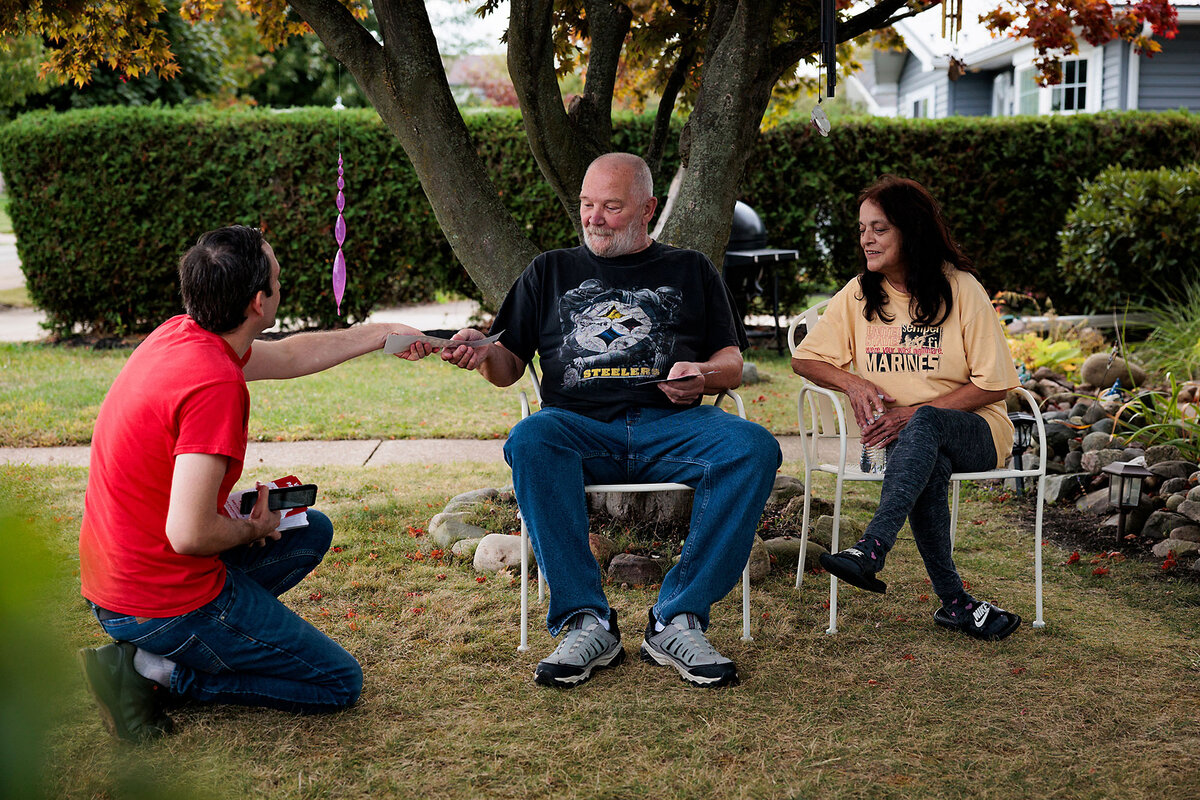
And tech failures can devastate a ground game, impacting the larger campaign. In 2012, Mitt Romney’s presidential campaign poured hundreds of thousands of dollars and a lot of staff hours into ORCA, a voter-targeting platform that was supposed to be a cutting-edge data operation that would let them respond in real time to information on the ground on Election Day. But ORCA crashed on Election Day, leaving the campaign flying blind without critical information.
Both The Guardian and The Washington Post have reported that Campaign Sidekick, the app Mr. Musk’s super PAC is relying on to gather data and log door knocks, has been glitchy and unreliable in areas where cellphone service is limited. According to The Guardian, when users don’t have fast internet connectivity, the app forces canvassers to use “offline walkbooks” that lack a geo-tracking feature and don’t always upload after reconnecting to strong internet, allowing hired door-knockers to potentially cheat by “speed-running” routes and just dropping campaign materials rather than knocking on doors to talk to people.
A GOP field strategist who has recently used the app says its reliability “depends on your location, depends on your city and where you are,” but adds that in their experience it isn’t any worse than other field apps they’ve used.
Trump campaign political director James Blair says the reports of the glitch aren’t accurate. “All tech we are relying on is performing adequately, any issues are immediately addressed, and of course – like any big organization – we have parallel backup systems as a failsafe,” he says.
A ground game for Trump, borrowing a page from DeSantis
Mr. Musk endorsed Mr. Trump immediately after the former president survived an assassination attempt in July. The tech tycoon and world’s wealthiest person has recently ramped up his political efforts in a big way, appearing onstage at a rally with the former president in western Pennsylvania this month, where he called the election “a must-win situation” and claimed that if Mr. Trump doesn’t win, “this will be the last election” in America. He hosted a town hall in suburban Philadelphia on Thursday afternoon to rally support for the president ahead of the state’s voting registration deadline.
“Pennsylvania is, I think, the linchpin of this election, and this election is going to decide the fate of America and along with the fate of America the fate of Western civilization,” Mr. Musk declared onstage Thursday.
While this is the first time in a general election that presidential campaigns have been able to coordinate so closely with super PACs on field operations, a similar framework was used during the primaries – by Trump rival Ron DeSantis. While the Florida governor’s campaign foundered against Mr. Trump, by all accounts its field operations worked well.
Ironically, many of those working at Mr. Musk’s super PAC are veterans of the DeSantis operation. Phil Cox, who ran Mr. DeSantis’ super PAC, and Generra Peck, who served for a time as Mr. DeSantis’ campaign manager, are playing key roles. So is former DeSantis spokesman Andrew Romeo, who traveled with Mr. Musk to Pennsylvania during his recent appearance with Mr. Trump, along with Chris Young, a GOP strategist who led the Republican National Committee’s field program in 2016 and whom Mr. Musk hired as his political consigliere in August. Mr. Romeo, America PAC’s spokesman, declined to comment for this article.
The super PAC is also using a novel workaround to try to circumvent prohibitions on paying people to register to vote. The group is offering supporters $47 for each swing-state voter they can get to sign a petition supporting the First and Second Amendments. The effort is a bank shot to incentivize conservatives to register to vote in those states, though there’s nothing stopping people who are already registered from claiming the money.
Trump is behind Harris in the money race
The effort comes as Mr. Trump’s team is running a leaner ground game than in 2020.
Mr. Trump has badly lagged behind Ms. Harris in fundraising since she entered the race – his campaign raised just over half the amount of money she did over the past three months, new FEC reports show. Her overall campaign staff is about three times the size of his. Mr. Trump’s own field operation is significantly smaller than it was when he lost a high-turnout race in 2020, though it’s much larger than the ragtag 2016 operation that delivered him the White House.
Mr. Trump’s team admits that its campaign is smaller than last time around, though they say this is intentional. ”We have a smaller paid staff than we did in 2020,” one senior Trump campaign staffer says. “That’s by design – 2020 was this massive, bloated operation.”
The campaign has put a much higher emphasis on identifying and targeting lower-propensity voters, looking to turn out the people least likely to vote, rather than focusing on the overall number of door-knocks. Trump campaign co-manager Chris LaCivita told donors in May that the campaign was focusing on “quality over quantity” in its field operations, according to The Washington Post.
Some swing-state chairmen and strategists say the smaller field program won’t be a liability.
“The field operation in Arizona is certainly smaller this cycle compared to four years ago,” says Brian Seitchik, an Arizona Republican strategist who was Mr. Trump’s state director in 2016 and regional political director in 2020.
Mr. Seitchik says a massive ground game would have offered “diminishing returns” because Mr. Trump is so well-defined in his latest White House run. “There really is a finite universe of gettable voters here, and I believe that’s what the campaign is focused on,” he says.
And many Republicans credited outside groups, including Mr. Musk’s, for picking up the slack.

In Michigan, state Republican Party chairman Pete Hoekstra, a former congressman who only took control of the party apparatus in April after a nasty intraparty fight, says efforts have “shifted to the outside groups because we didn’t have a [functioning] political party.” He says the state party, Mr. Musk’s group, other outside groups, and Mr. Trump’s campaign are all sharing the burden.
“The bottom line is we’re not lacking for resources in the state of Michigan. And the numbers are starting to show that,” he says.
Trump campaign says it hasn’t abdicated ground game
Mr. Trump’s campaign praised the work being done by Mr. Musk’s group and other conservative groups that are knocking on doors and making phone calls and said they were working well together, while disputing the idea that the campaign was taking a backseat to Mr. Musk’s operation.
“More is more, and we’re happy to take more [from outside groups], even if it’s imperfect, as long as it’s not hurting us. But the narrative that we’re relying on outside groups is just completely bogus,” says Mr. Blair, the Trump political director. “Our operation is prepared to deliver victory with or without outside support – but we are certainly grateful for all our external allies’ hard work and support and the work they are doing is very helpful.”
Republicans are making up a larger share of the early vote in swing states than four years ago – but that’s an apples-to-oranges comparison because of the 2020 COVID-19 pandemic, when Democrats flocked to mail-in voting and Mr. Trump discouraged his supporters from using it. Republicans have also made significant gains in voter registration statistics in key swing states including Arizona, Pennsylvania, North Carolina, and Nevada in recent months; Republicans beat Democrats by more than a two-to-one margin in new voter registrant numbers in the past week, which the Trump campaign was quick to highlight.
Ms. Harris’ campaign, meanwhile, boasts more than 2,500 field staff across more than 350 field offices nationwide – not to mention a constellation of outside groups also helping turn out Democratic-leaning voters.
A Trump campaign official says its campaign has a similar number of offices as Ms. Harris with “many hundreds of staff in the field,” and that its field operation was contacting “well in excess of 2 million” people a week. By comparison In 2020, the RNC and the Trump campaign boasted of making 182 million voter contacts.
Some Republicans are wondering if the effort will work
Mr. Blair says the Trump field program has already collected twice the number of hard IDs for Mr. Trump through field efforts than the entire 2020 campaign, with about three weeks to go until Election Day. “We’re really outperforming in every single battleground state,” he says.
And Mr. Musk’s operation isn’t the only one doing field work for Mr. Trump – Turning Point USA and the Christian conservative Faith and Freedom Coalition are also out helping turn out voters.
But other Republicans aren’t feeling as confident about the combined ground game effort – especially Mr. Musk’s role.
“I’m pretty worried,” says a GOP field specialist who ran a swing state’s field program for the RNC during a past Trump campaign. That strategist had been in touch with people involved in this year’s ground game, and said they saw symptoms of “a thrown-together field program” in Mr. Musk’s efforts.

Canada-India relations are at a new low. China could be the winner.
The breakdown in India-Canada ties highlights a growing trend of transnational repression by India and other nations – and could force Western allies into a difficult balancing act in Asia.
- Quick Read
- Deep Read ( 5 Min. )
-
Aakash Hassan Special contributor
An India-Canada dispute that began last year with the killing of a Canadian citizen and Sikh independence activist reached new heights this week. Canada expelled six diplomats amid accusations involving homicide, extortion, and harassment of Indian diaspora on Canadian soil.
India, which failed to cooperate with Canada’s investigation and calls the accusations “preposterous,” expelled six Canadian diplomats in return, sinking the bilateral relationship to historic lows.
Watchdog groups warn that transnational repression, in which governments reach beyond their borders to try to silence dissidents, is on the rise globally. Still, it’s more likely to be executed in authoritarian states than in democracies, and it’s even rarer to occur between two countries generally seen as friends.
The collapse comes at a time when Canada’s Western allies see India as a critical counterweight to China in the Indo-Pacific. And while the West has been shoring up economic and strategic ties with India, critics say it has looked away from evidence of increasing authoritarianism under Prime Minister Narendra Modi.
“If the allegations are true, and a country you are supposed to be trusting ... is carrying out acts of transnational repression on their soil, that is a very sobering thing to process,” says analyst Michael Kugelman.
Canada-India relations are at a new low. China could be the winner.

Canada’s expulsion of six Indian diplomats this week, amid accusations involving homicide, extortion, intimidation, coercion, and harassment of Indian diaspora on Canadian soil, is more than a spectacular breakdown in bilateral relations between two countries.
It comes at a time when Canada’s Western allies see India, the world’s most populous nation, as a critical counterweight to China in the Indo-Pacific. And while the West has been shoring up economic and strategic ties with India, critics say it has looked away from evidence of increasing authoritarianism under Prime Minister Narendra Modi.
“In many respects, the Canada-India issue right now is almost standing as a warning beacon to the entire Western alliance,” says Vincent Rigby, a McGill University professor and a former national security and intelligence adviser to Prime Minister Justin Trudeau. “How do you manage this kind of relationship with an emerging global power that we want to cooperate with and that we want to be on good terms with but who’s doing these kinds of things to their friends?”
Ottawa’s allegations that Indian government agents are linked to widespread violence against a Sikh minority in Canada, which India vehemently denies, are unprecedented. It’s not that transnational repression, in which governments reach beyond their borders to try to silence dissidents and which watchdog groups say is on the rise, hasn’t occurred in democracies. A former Russian spy and his daughter were found poisoned in Salisbury, England, in 2018 in a botched assassination attempt. But it’s much more likely to be executed in authoritarian or repressive states, and it’s even rarer to occur between two countries generally seen as friends.
Sikh activist killed
The Canadian dispute began with the killing of Hardeep Singh Nijjar, an Indian-born Canadian citizen who was shot dead in the parking lot of a Sikh temple he ran in Surrey, British Columbia, in June 2023. At the time of his killing, he was an active campaigner in a movement for an independent Sikh nation, known as Khalistan, which its supporters say will be carved out of India’s Punjab state. Mr. Trudeau publicly claimed that “agents of the government of India” had been linked to the killing, drawing denial and outrage from the Indian government.
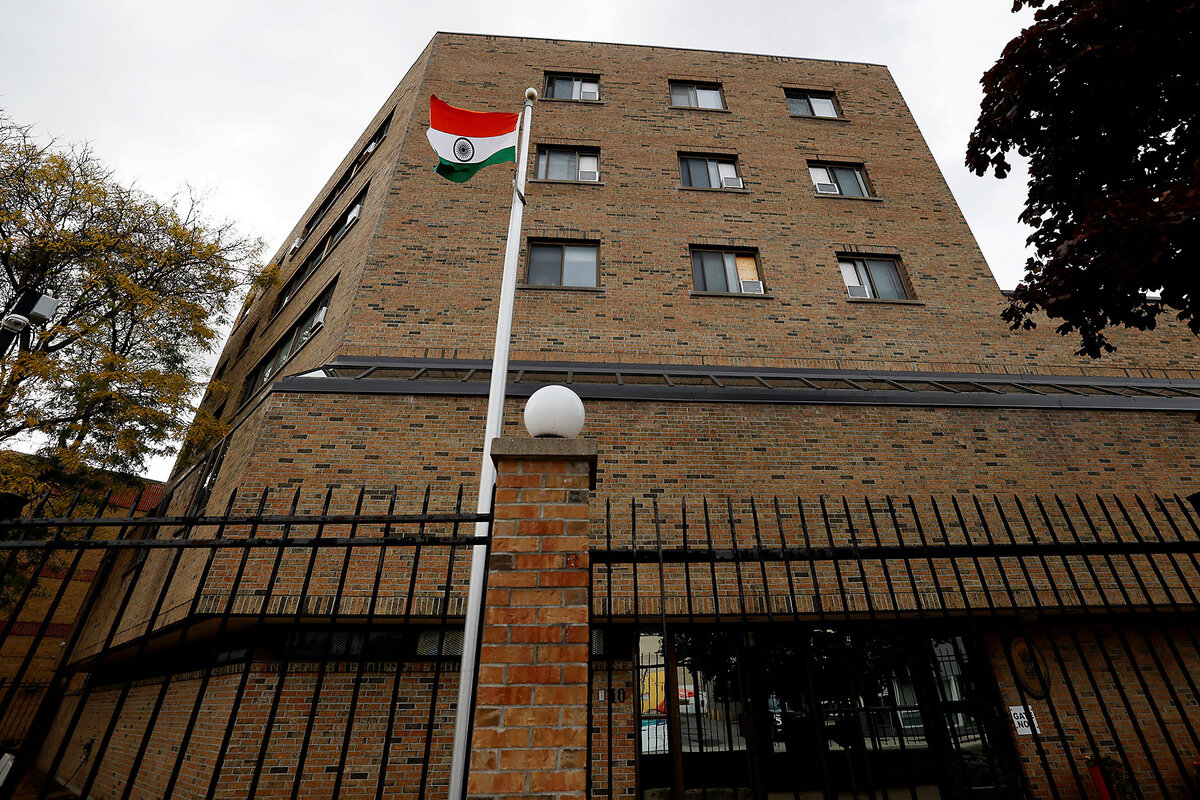
On Monday, with India failing to cooperate with Canada’s investigation, the government announced it was expelling India’s high commissioner to Canada and five other diplomats – with Canadian police alleging a much wider criminal campaign that they deemed so serious they went public.
“These are probably the gravest allegations against India made by another country ever,” says Praveen Donthi, senior analyst with the International Crisis Group in New Delhi.
India called the allegations “preposterous.” The government expelled six senior Canadian diplomats in return, sinking the bilateral relationship this week to historic lows.
But the charges are not isolated. On Thursday, the U.S. Justice Department filed murder-for-hire charges against a former Indian intelligence agent in connection with a foiled assassination attempt of a Sikh activist in New York City.
The case prompted a global Washington Post investigation that detailed “an escalating campaign of aggression by RAW [India’s spy agency, the Research and Analysis Wing] against the Indian diaspora in Asia, Europe, and North America.”
The public revelations could now force the West into a tricky balancing act with India, and come amid a worrying growth in transnational repression more globally, say watchdog groups.
A fundamental disconnect – and double standards?
Freedom House research director Yana Gorokhovskaia says that increasingly, governments are engaging in transnational repression to silence dissent for two main reasons. Global migration has led to much larger diasporas, and governments who commit it have faced very little accountability.
She cites the case of Jamal Khashoggi, the Saudi columnist for The Washington Post, who was assassinated in Turkey in 2018. The United States promised to turn Saudi Arabia into “a pariah state,” she says. “But relations are more or less normal between the U.S. and Saudi Arabia, and between Turkey and Saudi Arabia.”
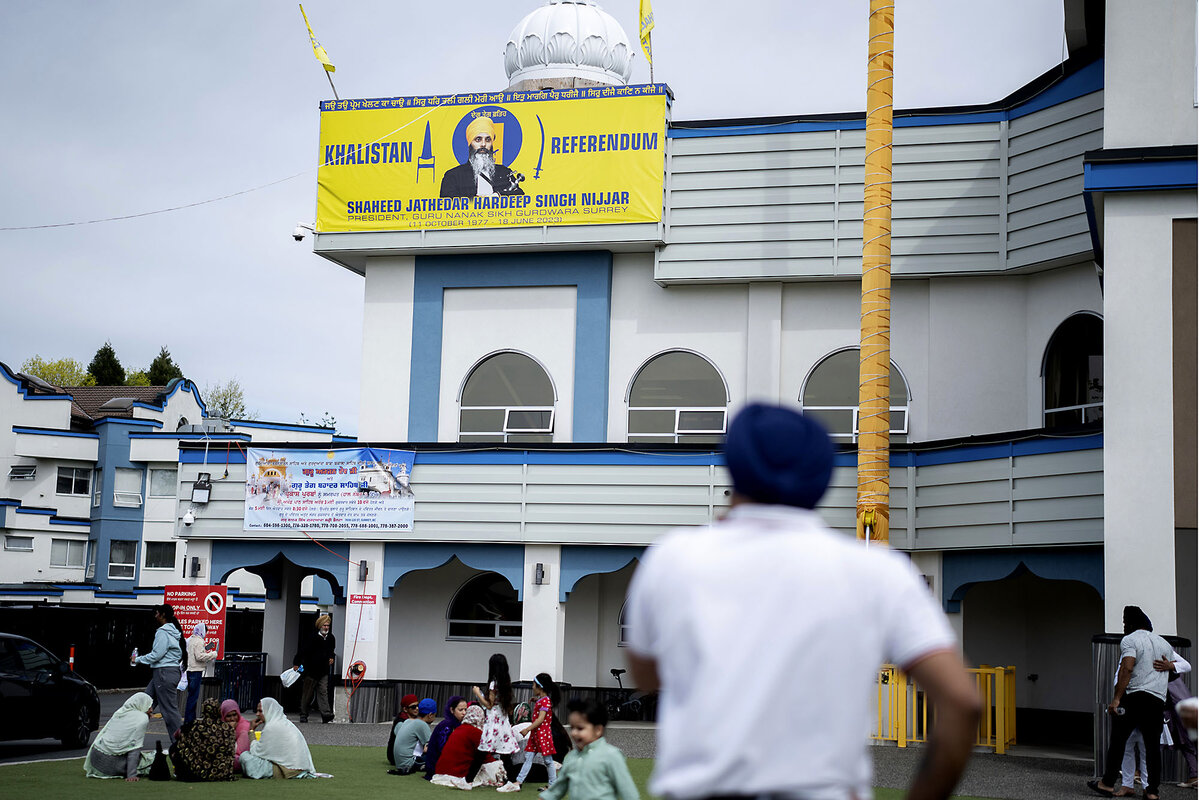
Sophie Duroy, a law lecturer at the University of Essex who specializes in intelligence and international law, says a precedent has been set by the U.S. and Israel, two states that have “normalized assassination” as a tool of statecraft. But she sees a double standard, depending on “who practices it, who is the victim, and on whose territory this happens on,” she says.
In this case, for example, Mr. Nijjar was deemed a terrorist by India in 2020. The Khalistan movement is banned in India, and its active advocates are mostly the Punjabi diaspora overseas. Canada hosts the largest Sikh population outside India, with Sikhs making up about 2% of the population.
Michael Kugelman, director of the South Asia Institute at the Wilson Center in Washington, says the relationship between Canada and India has been strained in recent years. Ultimately, there stands a fundamental disconnect between the two countries when it comes to the notion of Khalistan. “What India regards as a really serious potential threat, Canada regards as essentially activism protected by free speech,” he says.
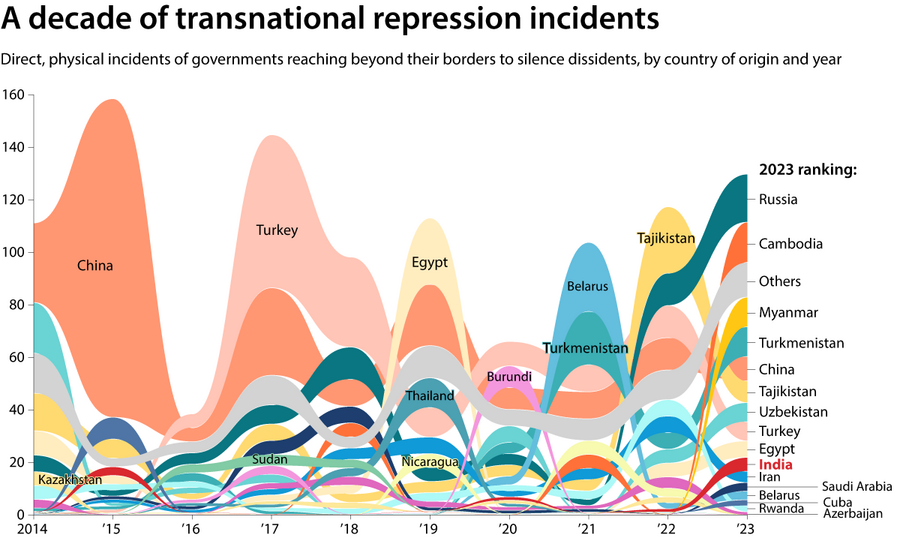
Freedom House
Allies react to Canada’s investigation
Western allies – particularly the Five Eyes intelligence group that includes Australia, Canada, New Zealand, the United Kingdom, and the U.S. – have publicly supported Canada’s investigation.
But Canada could find itself lonelier than it did when it raised the ire of China after it arrested Huawei’s Meng Wanzhou, given that India is seen as a strategic partner that countries such as the U.S. and Japan need to counter China’s influence in the Pacific.
India also stands to lose, as it remains dependent on Western allies to continue its rise on the global stage, says Mr. Donthi, the analyst. Delhi has cooperated with the U.S. investigation, but its denials in the Canada investigation generated global headlines this week in what Mr. Trudeau called a “horrific mistake” to interfere with Canada’s “sovereignty.”
“This mishap will cast doubts on the nature of the Indian state and affect relations” with the West, Mr. Donthi says. “The favorable external climate India enjoyed so far might not be the same after this.”
That is something opposition parties in India are watching, too.
Sagarika Goshe, an Indian parliamentarian from the Trinamool Congress party, says the opposition rarely pushes against Mr. Modi on issues of foreign policy, and the same is true now, with opposition leaders criticizing Canada’s allegations as hypocritical. But she adds that the prime minister should call a confidential, all-party meeting – as is typical in times of crisis – to “inform the leader of the opposition as to what is the truth.”
Senior opposition leader Jairam Ramesh agrees, writing on the social platform X that “Safeguarding India’s global standing is a shared responsibility.”
The bilateral dispute has not derailed India’s partnerships, but, depending on how it is resolved, it could force some inward thinking by those allies. “If the allegations are true, and a country you are supposed to be trusting and that’s your partner is carrying out acts of transnational repression on their soil, that is a very sobering thing to process,” says Mr. Kugelman.

Freedom House

Transformed FEMA faces torrent of challenges to growing relief efforts
Effective deployment of the nation’s emergency resources depends on the goodwill of public officials, responders, and citizens. That goodwill is being tested now, as is the Federal Emergency Management Agency’s agility, in North Carolina.

- Quick Read
- Deep Read ( 6 Min. )
Nearly 20 years after the Federal Emergency Management Agency’s flawed response to Hurricane Katrina in New Orleans, its efforts after floods in western North Carolina point to successful reforms, though FEMA remains a piñata for budget hawks and a culture war battleground.
The agency is short-staffed. A fragmented federal approach to disaster recovery compromises its programs. And suspicions about government intent or inaction have negatively impacted its effectiveness.
Still, FEMA soldiers on, ultimately holding both checkbook and playbook for recovery from extreme weather events.
And in the North Carolina towns of Bat Cave and nearby Hendersonville – both decimated by the rains of Hurricane Helene – there’s a sense of unity among many who formed impromptu emergency platoons to rescue neighbors.
“Until Katrina, disaster response was framed in terms of what the professional response was, with one decision-maker,’’ says Natalie Simpson, an emergency operations professor at SUNY Buffalo, referring to FEMA. Now, communities are starting “to focus on a common framework, a common language, and recognizing each other.”
Transformed FEMA faces torrent of challenges to growing relief efforts
The grim faces of police officers blocking a main road into Bat Cave, an iconic Appalachian community, underscore the trauma and tragedy of an epic flood that has left nearly 100 residents of the mountain region still missing.
“We don’t need anybody down there complicating what’s going on any more than it already is,” a police officer says.
Nearly 20 years after FEMA’s flawed response to Hurricane Katrina in New Orleans, the Federal Emergency Management Agency’s efforts in western North Carolina point to successful reforms that lean on local first responders, volunteers, and neighbors while providing key financial support for lifesaving and longer-term efforts.
Even as FEMA has improved, the current recovery efforts following Hurricane Helene also show how the agency has become a perennial piñata for budget hawks and a culture war battleground – complicating America’s already polarized views of what government in action means.
“Communities know how to pull together in times of crisis, and FEMA does the same thing – they don’t come riding in on horses with hats on and say, ‘We’re here!’” says Susan Cutter, a professor at the University of South Carolina in Columbia and co-director of its Hazards Vulnerability & Resilience Institute. But “what’s happened in western North Carolina is that [people] don’t necessarily want FEMA there – they do and they don’t. They don’t trust the government, and they haven’t trusted the government for a long time.”
By its own admission, the agency is short-staffed, and a fragmented federal approach to disaster recovery compromises its effectiveness. FEMA programs are spread across 30 different agencies, making coordination of recovery efforts almost impossible, according to a 2023 report by the U.S. Government Accountability Office.
But FEMA at least is well aware of how important it is for the agency to partner and coordinate with others on the front lines.
“There will never, ever be any single organization, never any one group of humans, that can possibly respond to the totality of a natural disaster,” says Natalie Simpson, an emergency operations management professor at the University at Buffalo.
And despite the increasing frequency and costs of disasters, and persistent criticism by both political parties, FEMA soldiers on.

FEMA staff have faced verbal attacks and the risk of physical harm. An armed North Carolina man was arrested on Oct. 12 after he threatened federal recovery workers, highlighting a dynamic where storm victims are questioning – and threatening – those tasked with helping them rebuild.
That same day, a U.S. Forest Service official sent an alert saying that National Guard troops “had come across … trucks of armed militia saying they were out hunting FEMA.’’ Although this report proved to be incorrect, FEMA operations were briefly paused in North Carolina’s Ashe and Madison counties as a result.
For some, the agency has become a symbol of government inefficiency and mismanagement.
For others, the question is not about intent but capacity: If climate change worsens how weather affects communities, how ready is America to respond?
“Until Katrina, disaster response was framed in terms of what the professional response was, with one decision-maker,’’ says Professor Simpson. “It’s been a 20-year journey to change the vision of large-scale emergency response to focus on a common framework, a common language, and recognizing each other.”
FEMA’s role – and the rising costs of extreme weather
Signed into existence by President Jimmy Carter in 1979, FEMA employs about 20,000 workers and faces more than 100 declared disasters per year on average. As the frequency of major disasters has steadily grown, so have costs: From 1980 to 2007, only one year had more than seven billion-dollar disasters. From 2019 to 2023 the average year had more than 20 such events, according to a Congressional Research Service report. A practice called “immediate needs funding” was implemented – to prioritize lifesaving measures when FEMA funds are scarce – following extreme weather disasters in 2010, 2011, 2017, 2023, and 2024.
In essence, FEMA holds both checkbook and playbook for recovery, even as many costs still land on local communities.
“FEMA operates on the premise that disaster response is federally supported, state managed, and locally executed,” says former FEMA recovery director Greg Eaton, now an emergency management professor at Purdue Global in West Lafayette, Indiana. “All disasters start and end locally.”
Hurricane Katrina, which pummeled Louisiana’s coast in the fall of 2005, became the organization’s nadir. Congress found the effort deeply flawed, partly because of inexperienced political appointees muddling efforts and partly because up to $2 billion of taxpayer dollars disappeared to fraud and waste, according to its investigators. In response, the agency undertook a deep transformation, hiring experienced first responders to administer the agency.
Current FEMA Administrator Deanne Criswell began her career as an emergency manager in Aurora, Colorado, finding housing and support for people displaced from Katrina.
Throughout the first days of rescue in Appalachia, an army of volunteers, including Louisiana state troopers, New York City firefighters, and Canadian power line workers joined local citizens in leading the initial response, which experts see as one sign of how the nation’s large-scale disaster response capabilities have strengthened.
Civilian pilot Nathan Smith also saw FEMA staff playing their part, as he flew supply missions into the North Carolina flood zone. “Those folks were doing their job and really working hard,’’ says Mr. Smith. “It was all-hands-on-deck.”
But as western North Carolina begins what will no doubt be a long rebuilding effort, local suspicions about the agency have mounted, amplified by national political figures sharing conspiratorial ideas.

Many citizens see local or nonprofit help as pivotal.
“What’s really driving the response isn’t the government, but the people,’’ says South Carolina resident Tracy Meink, a local cleanup coordinator whose father’s house down the road from Bat Cave flooded during Helene’s rains, when asked about FEMA’s response.
Citing delays in Defense Department troop deployments to the flood-wrecked region, “this wasn’t the response that the people of Western North Carolina deserved,” U.S. Sen. JD Vance, the Republican vice presidential nominee, wrote in an Oct. 8 Wall Street Journal op-ed.
Distrust of federal authorities
Suspicions about government intent or inaction have negatively impacted past emergency responses. During the 2020 wildfires in Oregon, for example, armed men hampered firefighting, fueled by unproved rumors that antifa had set the fires. After the Houston floods in 2017, false rumors that immigration officials would investigate citizenship status led many people to refuse aid.
“A lot of people don’t trust the authorities,” says Aaron Clark-Ginsberg, a policy analysis professor at the Pardee RAND Graduate School, in Santa Monica, California. “These people are survivors, and they’re victims as much as everyone else.”
It used to be that government officials who helped citizens during disasters were rewarded at the ballot box. But experts say being responsive is no longer enough.
“Deliverism is not really working anymore,” says Neil Malhotra, a political scientist at Stanford Graduate School of Business, in California, referring to the idea that economic policy can drive people’s political allegiances.
That reality is complicating Washington’s task.
The White House has asked Congress for an extra $4 billion for FEMA to respond to tornadoes and wildfires and rebuild Baltimore’s Francis Scott Key Bridge. Homeland Security Secretary Alejandro Mayorkas said on Oct. 2 that “we are meeting the immediate needs with the money that we have” but “FEMA does not have the funds to make it through the season.”
Amid those worries, recovery efforts here near Bat Cave and nearby Hendersonville have given way to a sense of unity among many who formed impromptu platoons to rescue neighbors.
Indeed, goodwill toward fellow Americans – reflected in interviews with survivors – may hint at the nation’s capacity to rally behind a robust disaster response.
In an atmosphere where many people are uncertain about the government’s motives, Professor Clark-Ginsberg says there is an opportunity to “provide factual, evidence-based responses in a nonconfrontational tone that can help change the narrative.”
Editor’s note: A paragraph with information on the frequency and cost of natural disasters was corrected on Oct. 18, this article’s date of original publication.

Q&A
How to have better conversations with people across the aisle
In a society riven by division, it can take courage to reach out to people who hold different views. We asked an expert on conflict transformation for tips.

- Quick Read
- Deep Read ( 5 Min. )
Bob Stains is a skilled communicator. He trains people to work through differences that crop up where they live, work, and worship.
Mr. Stains was talking recently with a man who clearly did not share his political or religious beliefs. “We could have had a conversation that was just ‘I disagree with your perspective, and I think you’re very wrongheaded.’ But I wanted to have a richer understanding of his story,” he says.
In circumstances like this one, Mr. Stains might ask if the person is willing to talk further about how they got where they are in their current thinking. He demonstrates a genuine curiosity with questions such as “Have you always felt the same way and with the same passion” about the issue?
“I ask, ‘Can they take me upriver a little bit and help me understand who influenced them? When did their thinking change?’ And I think if we do that for ourselves, too, it helps us to see ourselves as more complex people, and we are seen as a more complex person who’s easier to connect to.”
How to have better conversations with people across the aisle
How do we talk with those who hold views that are different from our own? What does real communication look like? These are questions that Bob Stains has thought about deeply over the decades. He’s trained tens of thousands of people in corporate, educational, and community settings how to work through conflicts.
Talking with people whose beliefs or lived experiences don’t mirror ours takes self-knowledge, kindness, and courage. The motivation to be “a repairer of the breach,” as Isaiah 58:12 describes it, also creates fertile ground in which the seeds of a richer, more honest dialogue can grow. And it helps to have tips from an expert. (Check out our book list for further reading on the topic.)
Mr. Stains starts from the premise that conflicts over identity, values, and worldview can’t be resolved. But they can be transformed. He spoke recently by video call with the Monitor. The interview has been edited and condensed.
How does looking into our own hearts unlock communication with others?
First, we have to ask ourselves, Are we really willing to go there? I use a lot of metaphors from Jewish and Christian Scriptures, and one I like is, “I will remove from you your heart of stone and give you a heart of flesh” [Ezekiel 36:26]. There’s a lot of advantages to hearts of stone. There are layers of protection. So the first question I have to ask is, How willing am I to soften my heart and let go of the protections that I’ve built around myself? And that can take a lot of work, right? Exploring how my heart has gotten stony with regard to particular people. So I do think that there is a piece of reflective practice that’s really helpful.
Many of us avoid conversations with people we see as difficult. How does asking questions and being curious help?
We’re often tempted to ask for what I call the simple story. We carry the simple story of the other person, and then we only ask things that confirm what we already believe.
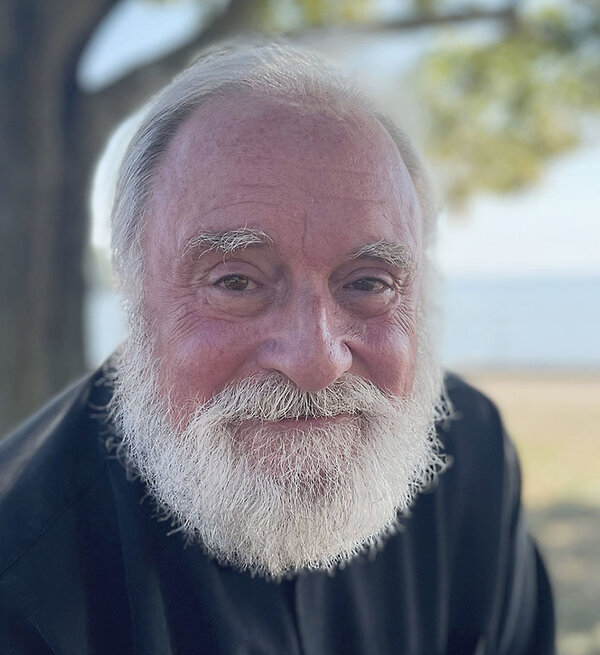
Instead, we can find the good. There’s a story in Jewish tradition, which Rabbi David Jaffe writes about in his book “Changing the World From the Inside Out,” that all of us carry a shard of crystal that reflects the image of God in some way. So “finding the good” is about having the belief that the other person carries something of the image of God. And asking ourselves, How can I help bring that to the surface, see it, and honor it?
If we decide to engage with someone, how do we encourage a deeper connection?
A lot of times, people stay stuck on their particular perspective: “I believe and I think this way.” And they’ve maybe lost touch with the fact that it’s been a journey to get to where they are.
So when people reiterate their position, I might say, “I understand where you are on this issue.” Then I may ask if they are willing to talk further about how they got there. Have they always felt the same way and with the same passion? Can they take me upriver a little bit and help me understand who influenced them? When did their thinking change? And I think if we do that for ourselves, too, it helps us to see ourselves as more complex people, and we are seen as a more complex person who’s easier to connect to.
Cultural anthropologist Mary Catherine Bateson talked about the “continuity story” – which comes from the questions we could all predict: where you went to school, where you got a degree. But then there’s the “discontinuity story” represented by questions like, Who were the people and the turning points that shifted you in another direction? Once people get the feeling that you’re interested in more than just whatever the facade is, most are very willing to open up. And then some are willing to ask in return.
Let’s say you’ve hit a wall in a conversation. You can’t get any further. What do you do?
Well, [American educator] Parker Palmer says, “When the going gets rough, turn to wonder.” And that’s a good thing to live by. What he means is, can I be genuinely curious and interested in the experience or perspectives of another person, apart from the desire to impose mine on them?
I’ll give an example. I was talking recently with someone who clearly did not share my political or religious beliefs. We could have had a conversation that was just “I disagree with your perspective, and I think you’re very wrongheaded.” But I wanted to have a richer understanding of his story.
I teach an exercise I call “Standing in the River.” You imagine you’re standing in the river with somebody who disagrees with you, and you shift to a sincere inquiry about what is the river that the person is standing in and what are their values, commitments, concerns. And then looking upstream, where have those come from? And then looking downstream, what is the fruit that they imagine if these values are upheld? That’s where you start to get complexity and nuance and overlap, like the Venn diagram where you discover shared values that will then build a more shared conversation. I tried it with this man, and we had a good exchange.
How do we talk with friends and family members – who may be on the “same side” as we are politically, but who make disparaging comments about the other camp – if we’re trying to not perpetuate a climate of conflict and incivility?
It’s important to interrupt that kind of talk, if you can. But you want to do it in a way that doesn’t repeat the kind of righteousness that keeps us stuck in this problem. I don’t want to say, “Well, you’re stupid because you think they’re stupid.” That’s not going to do any good. But what I want to do is bear witness to complexity – the complexity of people on the other side, and the complexity of the people I’m listening to.
Here’s a scenario: An activist friend wants me to join a political demonstration. I have reservations – and I don’t want to contribute to further polarization. What do I say?
Each person will have a different response. I’ve marched against guns in Boston, and there are things that I will take on, but my general response when I’m asked is, I enjoy the camaraderie and the motivation it gives me to act. But I don’t want to be involved in creating more polarization. These kinds of events, to me, can be about defining others as evil. That’s not to say that’s always the case, or that you should never participate, never stand up for your beliefs by marching, or whatever you choose to do.
How can you tell when someone is willing to talk?
I think you have to be sensitive to the moment and where people want to go. And some people don’t really want to go there and that’s OK.
For the people who do want to go there, one of the phrases I keep in mind is: What else? What else are they wanting to say but haven’t been asked? And that’s the whole frame of asking all those other questions.

In Pictures
Finding ‘Wonderland’ at the New York Botanical Garden
Lewis Carroll’s “Alice’s Adventures in Wonderland” has delighted children since the Victorian era. Some of his beloved characters are in larger-than-life form at this topiary exhibit in New York.

- Quick Read
- Deep Read ( 2 Min. )
At the New York Botanical Garden, you don’t need to go down a rabbit hole to encounter a 12-foot-tall White Rabbit made entirely of plants ... or to stand beneath larger-than-life kinetic mushroom sculptures.
Installations inspired by Lewis Carroll’s beloved children’s books are sprinkled throughout the 250-acre garden as part of the “Wonderland: Curious Nature” exhibit, which runs through Oct. 27. Inside the garden’s conservatory are many plant specimens appropriate to Carroll’s Victorian era. Leaves of elephant ear plants, already large, can grow as big as umbrellas.
Diana Dil poses for a photo encircled by her little girls, all in blue except for the youngest in pink. Behind them, the conservatory pool is filled with giant water lilies. A multicolored Alice peeks out from the foliage in the distance. The family has excitedly visited the “Wonderland” exhibit twice.
“I want to live here,” says Ms. Dil.
Expand the story to see the full photo essay.
Finding ‘Wonderland’ at the New York Botanical Garden
Alice might have thought she found Wonderland, but she hadn’t, because she never made it to the New York Botanical Garden’s latest exhibit. Here, you don’t need to go down a rabbit hole to encounter a 12-foot-tall White Rabbit made entirely of plants ... or to stand beneath larger-than-life kinetic mushroom sculptures.
Installations inspired by Lewis Carroll’s beloved children’s books are sprinkled throughout the 250-acre garden as part of the “Wonderland: Curious Nature” exhibit, which runs through Oct. 27. Inside the garden’s conservatory are many plant specimens appropriate to Carroll’s Victorian era. Leaves of elephant ear plants, already large, can grow as big as umbrellas.
Diana Dil poses for a photo encircled by her little girls, all in blue except for the youngest in pink. Behind them, the conservatory pool is filled with giant water lilies. A multicolored Alice peeks out from the foliage in the distance. The family has excitedly visited the “Wonderland” exhibit twice.
“I want to live here,” says Ms. Dil.






For more visual storytelling that captures communities, traditions, and cultures around the globe, visit The World in Pictures.
Other headline stories we’re watching
(Get live updates throughout the day.)The Monitor's View
How China’s women claim freedom
- Quick Read
- Deep Read ( 2 Min. )
-
By the Monitor's Editorial Board
For China’s annual blowout sales event on Nov. 11, when Singles’ Day is observed, the e-commerce giant JD.com decided this year to enlist a famous female stand-up comedian, Yang Li, for its marketing campaign. After all, young single women have become a powerful force for equality in Chinese society. They are also big shoppers in what is now the world’s largest online shopping event. The date, 11/11, was chosen three decades ago by a group of university students as a reason for celebration. The four digits symbolize singlehood.
The selection of Yang Li did not go well. The comedian is widely known for a one-line question about men: “Why are they so mediocre but still so confident?” The uproar on social media pushed JD.com to apologize on Friday for promoting her.
But the fracas only helped highlight a grassroots movement among young women with good incomes who see marriage as too costly or cannot find men who share their values. Many are also challenging government pressure for them to become wives and mothers – and reverse China’s population decline. They are also quietly claiming a personal freedom by touting their solo consumerist lifestyles.
How China’s women claim freedom

For China’s annual blowout sales event on Nov. 11, when Singles’ Day is observed, the e-commerce giant JD.com decided this year to enlist a famous female stand-up comedian, Yang Li, for its marketing campaign. After all, young single women have become a powerful force for equality in Chinese society. They are also big shoppers in what is now the world’s largest online shopping event. The date, 11/11, called “bare sticks day,” was chosen three decades ago by a group of university students as a reason for celebration. The four digits symbolize singlehood.
The selection of Yang Li did not go well. The comedian is widely known for a one-line question about men: “Why are they so mediocre but still so confident?” The uproar on social media pushed JD.com to apologize on Friday for promoting her.
But the fracas only helped highlight a grassroots movement among young women with good incomes who see marriage as too costly or cannot find men who share their values. Many are also challenging government pressure for them to become wives and mothers – and reverse China’s population decline. They are also quietly claiming a personal freedom by touting their solo consumerist lifestyles.
The women find that “a new sense of economic liberty helps to define themselves and their place in Chinese society,” wrote two scholars, Chih-Ling Liu and Robert Kozinets, in a 2020 essay in The Conversation. “Single professional Chinese women are changing how others see them not through protest or activism – but through their economic power.”
Many of the women make video blogs for the social media site Xiaohongshu (“Little Red Book”) to show off their “refined” lifestyle. They are creating an individual identity in a society where the Communist Party increasingly does not see a person’s private life as private and whose ruling Politburo has no women among its 24 members.
“These women frame singledom as freedom,” wrote Guo Jia, a researcher at the University of Sydney, for the website Sixth Tone. One study of the vloggers finds the women are narrating their “choice of living a single life as an autonomous and empowering decision.”
China’s e-commerce giants certainly know who these frequent shoppers are. And for this year’s Singles’ Day, they once again are trying anything to win them over. Even in a repressive state, freedom to define one’s identity finds a way.

A Christian Science Perspective
Each weekday, the Monitor includes one clearly labeled religious article offering spiritual insight on contemporary issues, including the news. The publication – in its various forms – is produced for anyone who cares about the progress of the human endeavor around the world and seeks news reported with compassion, intelligence, and an essentially constructive lens. For many, that caring has religious roots. For many, it does not. The Monitor has always embraced both audiences. The Monitor is owned by a church – The First Church of Christ, Scientist, in Boston – whose founder was concerned with both the state of the world and the quality of available news.
Our spiritual location – permanent and safe
- Quick Read
- Read or Listen ( 3 Min. )
-
By Sue Brightman
Glimpsing that our real home is within divine Love brings healing.
Our spiritual location – permanent and safe
One night after several busy days in New York City, I went back to my hotel room overlooking Times Square, and as I got ready for bed everything seemed to be pulsating. Billboards flashing messages, throngs of people on the streets below – even the building’s air conditioning seemed to be emanating energy.
I went to sleep as usual but awoke with a sense of disorientation and anxiety. I was close to panic. I realized that it was imperative to relocate myself – not physically but spiritually, as a dweller in Truth and Love.
I turned to that week’s Bible Lesson from the “Christian Science Quarterly.” The opening Bible verse asked, “O Lord God of hosts, who is a strong Lord like unto thee? or to thy faithfulness round about thee?” This was followed by the affirmation, “The heavens are thine, the earth also is thine: as for the world and the fulness thereof, thou hast founded them” (Psalms 89:8, 11).
The theme continued to enlarge upon God’s creation of the universe as good and perfect and God as supreme and loving. Within minutes, the disorientation and anxiety dissipated, drifting away as if never there. My awe and gratitude at the reversal were beyond words. I slept peacefully the rest of that night, and the following night, too.
Knowing what and where we are – immortal, made in God’s image and likeness – enables us to navigate our steps with dominion. The Christ, the spiritual idea of Truth and Love, gives us confidence even in the midst of jarring influences. We are never suspended, unmoored, or disassociated from our intimate relation to God, good.
Mary Baker Eddy, the discoverer of Christian Science, writes in one of her sermons, “Our surety is in our confidence that we are indeed dwellers in Truth and Love, man’s eternal mansion” (“Pulpit and Press,” p. 3). Our true dwelling place is God, who is Truth and Love.
Some years earlier, I was visiting another city. While walking across an arched bridge over a waterway, I found myself behind an open cart piled high with furniture. At the top of the bridge, the worker pulling the cart lost control of it, and some of the furniture toppled, landing on me. My leg was hardest hit, and the pain was penetrating.
I felt alerted to locate myself spiritually, and as I prayed this divinely inspired message came to thought: “There is only one city and one place” – meaning that we are all perfectly held in God and His kingdom.
I realized that I could be nowhere but in that one city: all-encompassing divine Love. I was aware of and at home in this Love, mentally transported beyond any dramatic human scene. In that moment, I understood that all is Love – that geographic borders were human concepts that could neither define nor limit the beauty of my experience.
I felt connected to all that is good and to my fellow man. I felt love for the worker who had been pulling the cart and for all those around me, who now felt like neighbors. The pain subsided. I had no fear about the incident. The spiritual awareness of my location as never interrupted or marred was like a sacred bubble in which I felt enveloped for the rest of my time there.
A few days later, I met up with a friend as planned. We hiked steep and challenging paths. I had full freedom of my leg and ankle and felt no pain or limitation of any kind.
The perfect city that I had glimpsed in my consciousness was “the city [that] lieth foursquare” (Revelation 21:16). This is the eternal city in which we all reside. It is our oneness with the Father, God, an unbroken and intimate connection with our creator, Love, which can be experienced here and now.
“Science and Health with Key to the Scriptures” by Mrs. Eddy says that this city described by St. John indicates the present possibility of perceiving and experiencing divine Love’s allness (see p. 574).
In difficult situations, reaffirming our spiritual location provides glimpses of divine reality – of all-encompassing divine Truth and Love, which include all and embrace all. Locating ourselves rightly is healing. It happens within thought and is the activity of Christ, which is ever-present, ever-active, ever-centering. We can never be outside of or displaced from our oneness with God, divine Love.
Adapted from an article published in the Feb. 5, 2024, issue of the Christian Science Sentinel.

Viewfinder
Comet of the century

A look ahead
Thank you for joining us this week. Among the stories we’re working on for next week are a look at how ready Israel is for a cease-fire and a three-part series on Sudan – bringing you a rare, in-depth portrait of a crisis that the world has largely overlooked.


